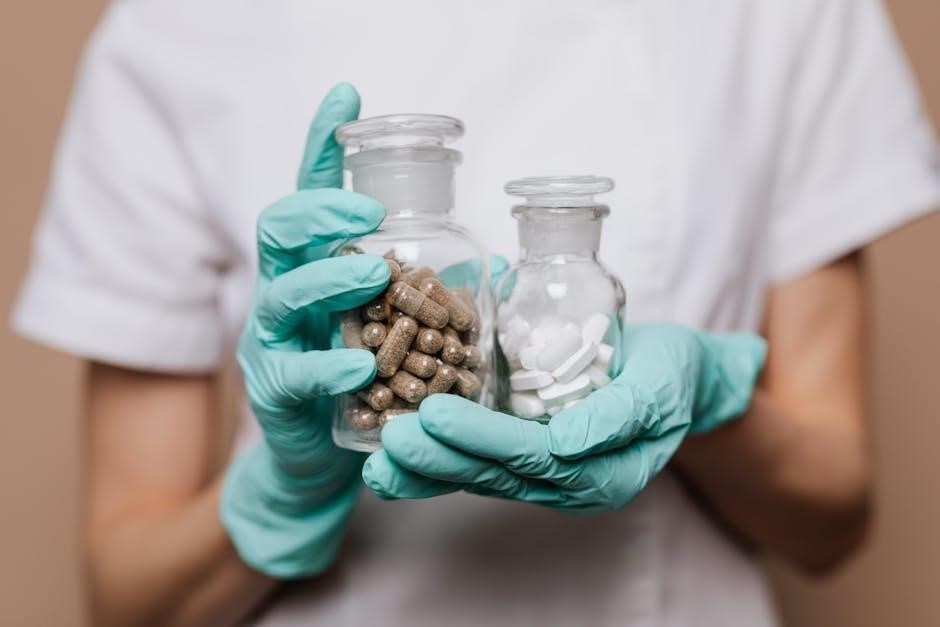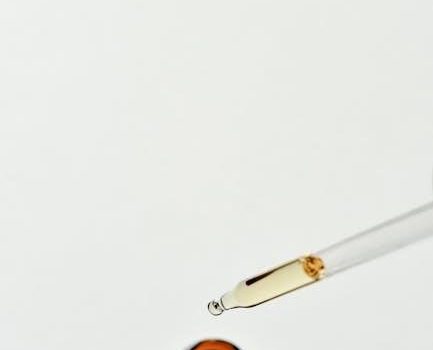peptide dosage guide
Category : Guide
This guide provides a comprehensive overview of peptide dosing, emphasizing accuracy for maximizing benefits and minimizing side effects. It covers popular peptides like BPC-157, TB-500, and CJC-1295, detailing factors influencing dosage, such as concentration, individual goals, and potency, while offering practical advice on measurement and administration for safe and effective use.
Understanding the Importance of Accurate Peptide Dosage
Accurate peptide dosage is crucial for maximizing therapeutic benefits while minimizing side effects. Proper dosing ensures optimal bioavailability and efficacy, tailoring to individual goals and tolerance levels. Incorrect dosages can lead to reduced effectiveness or adverse reactions, emphasizing the need for precise calculation and measurement using tools like insulin syringes. This approach ensures safety and desired outcomes, making it a cornerstone of peptide therapy.
Overview of Popular Peptides and Their Uses
Popular peptides include BPC-157, known for tissue repair and gut health; TB-500, used for systemic healing and muscle recovery; and CJC-1295, which stimulates growth hormone production. Each peptide has unique benefits and applications, from enhancing recovery to promoting growth, making them versatile tools in therapeutic and performance-enhancing regimens. Their specific uses and mechanisms of action are detailed to guide optimal selection and application.

Factors Influencing Peptide Dosage
Peptide dosage is influenced by concentration, individual goals, tolerance levels, peptide potency, and vial specifications, ensuring personalized and effective treatment plans.
Concentration and Vial Specifications
Peptide dosage is heavily influenced by vial concentration and volume, as higher concentration requires precise measurement; For example, a 1mg vial of BPC-157 in 1mL of BAC water yields 250mcg per 25 units, while a 10mg vial in 2mL provides 250mcg in 5 units. Accurate measurement using an insulin syringe ensures correct dosing, emphasizing the importance of understanding vial specifications for safe and effective peptide administration.
Individual Goals and Tolerance Levels
Peptide dosages vary based on individual goals, such as tissue repair or muscle growth, and tolerance levels. Lower doses are recommended for newcomers to avoid side effects, while experienced users may opt for higher concentrations. Tailoring dosage to personal objectives ensures effectiveness and safety, emphasizing the need for personalized approaches in peptide therapy to achieve optimal results without unnecessary risks.
Peptide Potency and Half-Life
Peptide potency and half-life significantly influence dosage. Potency determines the strength of the peptide’s effect, while half-life affects how frequently it must be administered. Shorter half-lives, like BPC-157, require more frequent dosing, while longer ones, such as CJC-1295, offer sustained effects. Understanding these factors ensures proper scheduling and optimal therapeutic outcomes, balancing efficacy and convenience for users.
Popular Peptides and Their Recommended Dosages
This section provides detailed dosage recommendations for widely used peptides, including BPC-157, TB-500, and CJC-1295. Each peptide’s standard dosing range, optimal frequency, and common uses are highlighted, ensuring users can make informed decisions tailored to their health goals and tolerance levels.
BPC-157: Dosage for Tissue Repair and Gut Health
BPC-157 is commonly dosed at 250-500mcg daily for tissue repair and gut health. A 1mg vial typically requires 1mL of BAC water, with 250mcg equivalent to 25 units. For a 10mg vial (2mL BAC water), 250mcg is 5 units. This peptide is known for its healing properties, reducing inflammation, and promoting gut integrity. It can be administered subcutaneously or intramuscularly for optimal results.
TB-500: Dosage for Systemic Healing and Recovery
TB-500 is typically dosed at 2-2.5mg per week, split into two injections for systemic healing and recovery. It is commonly administered via subcutaneous or intramuscular injection. This peptide enhances cell regeneration, joint health, and muscle repair. Users often stack it with BPC-157 for accelerated healing. The standard cycle length is 4-6 weeks, with doses not exceeding 5mg weekly to avoid potential side effects.
CJC-1295: Dosage for Growth Hormone Stimulation
CJC-1295 is commonly dosed at 150mcg daily, administered subcutaneously, preferably in the morning or before bed. This peptide stimulates growth hormone secretion, promoting muscle growth and fat loss. A typical cycle lasts 4-6 weeks, with some users extending up to 12 weeks. Dosages exceeding 300mcg daily are often unnecessary and may increase side effects like joint pain or flu-like symptoms.

How to Calculate Peptide Dosage
Use an insulin syringe (U-100) to measure doses accurately in units, ensuring precise calculation based on peptide concentration and desired dosage for safe administration.
Using a Peptide Dosage Calculator
A peptide dosage calculator simplifies the process by allowing users to input vial concentration and desired dose, providing instant recommendations. These tools minimize calculation errors, ensuring accurate and safe dosing. They often include step-by-step instructions and considerations for peptide potency and individual tolerance, making them indispensable for both newcomers and experienced users.
Measuring Dosage with an Insulin Syringe
Using an insulin syringe (U-100) is a precise method for measuring peptide doses. Each unit on the syringe corresponds to 10mcg of peptide, allowing for accurate administration. For example, a 250mcg dose requires 25 units. This technique ensures consistency and minimizes errors, making it a preferred choice for peptide administration among users and practitioners alike.

Administration and Timing Guidelines
Administer peptides at optimal times, often subcutaneously or intramuscularly, to maximize bioavailability. Timing may vary; common practices include injecting in the morning or before meals for stability.
Best Practices for Injection Techniques
Use insulin syringes for precise measurement and subcutaneous or intramuscular injections. Rotate injection sites to avoid irritation. Ensure sterile techniques and proper preparation of peptides. Administer slowly and at room temperature for comfort. Consult a healthcare professional for personalized guidance to ensure safety and efficacy.
Optimal Timing for Peptide Administration
Timing is crucial for maximizing peptide bioavailability. Administer peptides like Ipamorelin and CJC-1295 before bed to align with natural growth hormone secretion. TB-500 is best taken in the morning to support daily recovery. Some peptides, such as GHRP-6, may require multiple daily doses due to shorter half-lives. Consistency in timing enhances efficacy and ensures stable peptide levels in the body.

Safety and Side Effects
Peptide therapy is generally safe but can cause side effects like injection-site irritation or mild fatigue. Proper dosing and medical consultation minimize risks, ensuring safe use.
Common Side Effects and Mitigation Strategies
Common side effects of peptide use include injection-site reactions, mild fatigue, or dizziness. To mitigate these, ensure proper injection technique, stay hydrated, and maintain a balanced diet. For hormonal peptides, monitoring hormone levels and adjusting doses under medical supervision can prevent imbalances. Always consult a healthcare professional if side effects persist or worsen, and adhere to recommended dosages to minimize risks.
Contraindications and Special Considerations
Certain peptides are contraindicated in pregnancy, breastfeeding, or autoimmune conditions. Individuals with cancer or uncontrolled medical conditions should avoid specific peptides. Always consult a healthcare provider before starting peptide therapy, especially if on other medications. Special considerations include monitoring for allergies and ensuring proper storage and handling of peptide products to maintain potency and safety.

Stacking Peptides for Enhanced Results
Stacking peptides like BPC-157 with TB-500 can optimize tissue repair and recovery. Combining GHRP-6 with CJC-1295 enhances growth hormone secretion for better muscle growth and fat loss, maximizing therapeutic benefits.
Popular Peptide Stacks and Their Dosages
A popular stack combines BPC-157 (250-500mcg/day) and TB-500 (2-2.5mg/week) for enhanced tissue repair and recovery. Another effective stack pairs GHRP-6 (100mcg/day) with CJC-1295 (150mcg/day) to boost growth hormone levels, promoting muscle growth and fat loss. These combinations are tailored to maximize synergistic effects while maintaining safety and efficacy for optimal results.
How to Safely Combine Different Peptides
When combining peptides, start with low doses and monitor effects to avoid adverse interactions. Consult a healthcare provider to tailor stacks to your goals and health status. Ensure each peptide’s half-life and mechanism align to optimize synergy without overloading your system. Research each peptide’s profile to maintain safety and achieve desired outcomes effectively.

The Future of Peptide Dosing
The future of peptide dosing lies in personalized plans and advanced delivery methods, leveraging AI for precise calculations and innovative technologies for optimal therapeutic outcomes.
Emerging Trends and Technologies
Emerging trends in peptide dosing include the use of AI-driven platforms for personalized dosage calculations and nanotechnology for targeted delivery systems. These advancements aim to enhance bioavailability and precision, ensuring optimal therapeutic outcomes. Additionally, microdosing strategies are gaining traction, allowing for lower, more efficient doses that reduce side effects while maintaining efficacy.
Future technologies may also incorporate wearable devices for real-time monitoring and customizable peptides tailored to individual genetic profiles. These innovations promise to revolutionize peptide therapy, making it safer, more effective, and accessible to a broader range of users.
Personalized Dosage Plans and Advanced Delivery Methods
Personalized dosage plans are tailored to individual health needs, optimizing peptide therapy. Advanced delivery methods like transdermal patches and oral formulations enhance bioavailability, making treatment more convenient. These innovations ensure safer, more effective peptide use.
This guide provides essential insights into peptide dosage, ensuring safe and effective use. By following personalized plans and advanced methods, users can maximize benefits while minimizing risks.
Key Takeaways for Safe and Effective Peptide Use
Accurate peptide dosing is crucial for maximizing benefits and minimizing side effects. Always use a peptide dosage calculator and consider factors like concentration, potency, and individual tolerance. Consult clinical guidelines and expert recommendations for specific peptides. Proper injection techniques and timing enhance efficacy. Prioritize personalized plans and consult healthcare professionals to ensure safety and optimal results.
